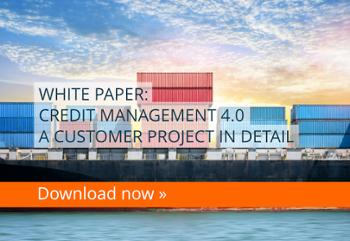
In the credit business, especially in the corporate loan area, a large amount of information is required, processed, and exchanged to be able to process a loan application completely. Manual processes and analog data management slow down the process and increase the risk of erroneous or missing data. This leads to problems, at the latest at the interface between customer service and the credit department, since large amounts of data have to be recorded and exchanged here. By completely mapping all application elements in a digital workflow, information asymmetries between front and back office can be avoided, meaningful analyses can be created and customer satisfaction can be improved.
No matter whether new application, follow-up application, or change: If the customer's data is not entered accurately when the application is submitted, the processing effort in the follow-up process increases exponentially. The more data is linked to this process, the more serious are the effects and the greater the coordination effort between front and back office. The scope of a loan application depends largely on the type of application - a private loan, the financing of a commercial property or major projects such as the financing of a wind power plant entail different processes.
However, all types of credit have one thing in common: With a structured digital application process, the smooth flow of all subsequent processes can be achieved, so great importance should be attached to data consistency. For example, application elements individually adapted to current requirements mean that all relevant information is recorded for each partial application and is available for further processing. Later inquiries to the account manager become the rate exception. Important prerequisite: Front and back office must be connected to a shared system and work with the same data then the subsequent linking of the application data in the process context can be guaranteed. This also avoids duplication of information or erroneous data due to media discontinuities from scratch. At the same time, the foundation is laid for the automation of subtasks.
Application types and motives are manifold
An application is any relevant reason that entails a processing step. This occasion can not only come from completely different areas or segments of the credit business, but it can also be caused by a wide variety of triggers. The most common scenario: The customer has a specific request and contacts the bank personally or by telephone. For example, he needs a loan for a short-term investment at short notice or would like to carry out a collateral swap.
However, there are many other ways of approaching the bank, whether this is in the retail or corporate banking area. The booming online sector is still being neglected by many banks and the information generated here is often not considered the ongoing application processes. In addition, applications can also be submitted by external partners, requested by a bank employee, or initiated automatically by the system.
Information from omnichannel-Banking and the legacy system must also be included in the application processing
In a modern banking environment, other contact channels are gaining importance besides traditional personal customer service. E-mail or chat communication with the bank advisor, online platforms for the use of the service functions or document uploads, smartphone apps for particularly fast information provision, interaction platforms of cooperation partners as an additional interface. These points of contact complement the classic relationship with the customer advisor and are available to the customers 24/7.
The customer often uses several contact channels in parallel and, depending on the motivation, has different expectations of the medium used - the processing of an application, the answering of a question, or the processing of submitted documents. At the same time, however, they expect all their data to be taken into account when processing their applications at a later date.
It can be concluded from this that in the interests of a seamless customer journey, the top priority must be to network the information from the various sales channels (keyword: omni-channel banking) in order to create a unified data basis, to support fast reactions to customer requests and to make optimum use of all information. In addition, there are also requests that are generated automatically from the banking system. The range of such occasions is wide. Frequently cited examples are regular commitment checks or the processing of loan prolongations. Often, different applications are even submitted in the same period or in periods that are close to each other.
Practical example: Application processing for a corporate customer loan without information link
 A corporate customer comes to the branch and applies for a loan to finance a new machine for his company. An online portal for digital application acceptance is currently not available for IT infrastructure reasons. Therefore, he must submit the relevant documents to the bank by hand, by post, or by e-mail. Employees vet the extensive documents, enter the data manually into an office template and contact the customer advisor if they have any queries, whereby it is noted that further documents are required. The customer must contact the customer advisor again.
A corporate customer comes to the branch and applies for a loan to finance a new machine for his company. An online portal for digital application acceptance is currently not available for IT infrastructure reasons. Therefore, he must submit the relevant documents to the bank by hand, by post, or by e-mail. Employees vet the extensive documents, enter the data manually into an office template and contact the customer advisor if they have any queries, whereby it is noted that further documents are required. The customer must contact the customer advisor again.
After some time, when all necessary information and documents concerning this application have been received and processed, the customer advisor must contact the customer again. He was informed by a colleague in Collateral Management that other documents are now required concerning the regular review of the property cash flow, of a commercial property that serves as collateral. Repeated contact within a short period of time costs additional resources, has an unprofessional effect and burdens the relationship of trust. The impression arises that the customer advisor has no overview of his customer's data.
Solution approach: Processing LOAN applications with a digital LOAN Application template
The use of a so-called digital loan application template links the data from the various sources of application processing and avoids information deficits. The digital loan application template acts in the process as a central interface between all interaction channels and existing systems. This also makes it possible to connect an online application platform without the risk of duplicate or inconsistent data storage. The process is also made considerably easier for the customer. For example, customers are able to see online which documents are required for their application and upload them to the system at any time, they can call up the processing status of their loan application, and so on.
In addition, a digital loan template can support the combination of several applications, even from different segments. The processor would then have recorded both requests mentioned in the example and initiated the necessary steps in time. Another advantage for both sides: Every account manager can track the processing status of a loan application in the system at any time and can thus also provide immediate information. Questions and delayed answers to the customer no longer exist.
Further variants of technological support in the application phase:
- Automated filling of requests from existing customers
- Automated completeness check and plausibility check of the documents to be submitted
- System-side triggering of additional document requests to the customer
- Accumulation of applications for existing customers, -accounts, -collateral with information from existing systems for easy knowledge transfer
- Generation of automatic requests from resubmissions (e.g. monitoring deadlines) or external system triggers (e.g. early warning signals)
- System-supported task distribution via a clear process portal
Conclusion
The aim of digital application registration at the front office is, in addition to a comprehensive requirement analysis, also a structured collection of the relevant information for further processing. Flexible capture logic and the use of intelligent assistance systems that access linked data in the background, significantly reduce the effort of data entry for the customer advisor. At the same time, the system also supports the customer advisor in structuring the customer dialogue and in finding the appropriate product.
In addition to the data generated during traditional customer service at the customer advisor's site, the data from all connected information sources, such as online portals or mobile applications, must also be automatically included in the current application process. By using a digital loan application template, all employees of a financial institution have real-time access to the processing status of an application.
A consistent structuring of processes between the front and back office, without media discontinuities and the associated loss of information and time, leads to noticeable increases in efficiency in the processing of loan applications. Detailed information on processing and throughput times in conjunction with detailed data on the individual processes, such as reasons for termination, decisions of the competence leader, etc., also provide a solid foundation for further evaluations.
Learn more in our expert whitepaper about the five key success factors that you should focus on when realizing your digitization project.
Image Source: Teaser: wutwhanfoto - 843617064 - iStock









